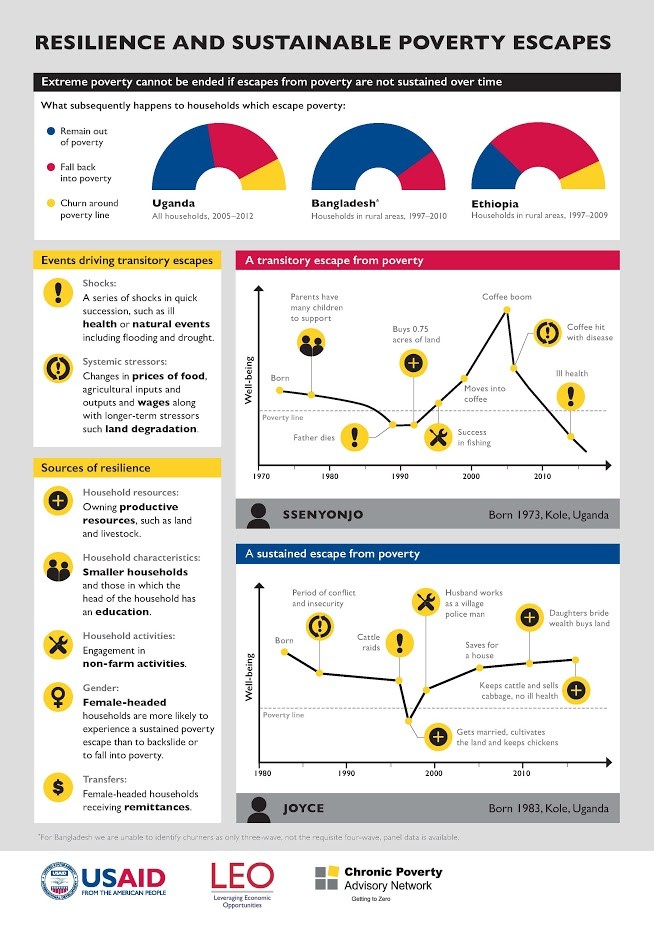
How many households escape poverty only to slide back in again later? How many hover around the poverty line perpetually, never sustainably escaping from poverty? What household characteristics and factors (sources of resilience) improve the chance of sustainable poverty escapes?
These questions, and others, were examined in research conducted by the USAID Leveraging Economic Opportunities (LEO) project to explore sustainable poverty escapes. The research focused on households in Bangladesh, Ethiopia, and Uganda. Country case studies were published for Bangladesh, Ethiopia, and Uganda, along with a methodological note on conducting poverty dynamics research.
The research found that sources of resilience include:
- Productive asset ownership.
- Smaller household size, and education level of the head of household.
- Engagement in non-farm activities.
- Female heads of household.
- Remittances
What subsequently happens to households which escape poverty:
- In Uganda, most people either remain out of poverty or fall back into poverty. A small portion churn around the poverty line. All households 2005.
- In Bangladesh, the majority of people remain out of poverty with a smaller portion that fall back into poverty. Households in rural areas 1997-2010.
- In Ethiopia, a larger percentage of people fall back into poverty. About a quarter of the people remain out of poverty. A small portion churn around the poverty line. Households in rural areas 1997-2009.
Events driving transitory escapes
- Shocks: A series of shocks in quick succession, such as ill health or natural events including flooding and drought.
- Systemic stressors: Changes in prices of food, a gricultural inputs and outputs and wages along with longer-term stressors such land degradation.
Sources of resilience
- Household resources: Owning productive resources, such as land and livestock.
- Household characteristics: Smaller households and those in which the head of the household has an education
- Household activities: Engagement in non-farm activities.
- Gender: Female-headed households are more likely to experience a sustained poverty escape than to backslide or to fall into poverty.
- Transfers: Female-headed households receiving remittances.
Case Studies
A transitory escape from poverty - Ssenyonjo's story.
Ssenyonjo was born in 1973 in Kole, Uganda. Ssenyonjo's parents found it difficult to support their large family, and each year the family dropped closer to the poverty line. In the late 1980s Ssenyonjo's Father - the now impoverished family's primary income earner - died, the first of several sudden shocks that feature prominently in Ssenyonjo's life story. A few years later Ssenyonjo bought .75 acres of land and started farming, and began the slow climb out of poverty. Success in fishing a few years later and a shift to coffee cultivation in the late 1990s allowed Ssenyonjo to continue improving his wellbeing, but caused a near-total reliance on agriculture for income. The end of the coffee boom in 2005 was another major shock to Ssenyonjo, causing his measures of wellbeing to regress, and further exacerbated by a coffee blight just a few years later. By 2015, Ssenyonjo has fallen below the poverty line once again, and that downward trend will likely continue as he is affected by ill health.
A sustained escape from poverty
Joyce was born in 1983 in Kole, Uganda. A period of conflict and insecurity - a systemic stressor - contributed to her declining wellbeing measures and in the mid-1990s cattle raids plunged her family's wellbeing below the poverty line. Joyce's wellbeing began to improve shortly after she got married and began to cultivate the land and keep chickens. Her husband worked as a village police man, giving the family a non-agricultural source of income, and by 2005 Joyce had climbed above the poverty line and was saving to buy a house. In 2011 her daughter's bride wealth enabled Joyce to buy more land, and she began to keep cattle and sell cabbage. Importantly, no ill health concerns affected Joyce's family, allowing them to continue to improve their wellbeing.
*For Bangladesh we are unable to identify churners as only three-wave, not the requisite four-wave, panel data is available.







Comment
Make a general inquiry or suggest an improvement.